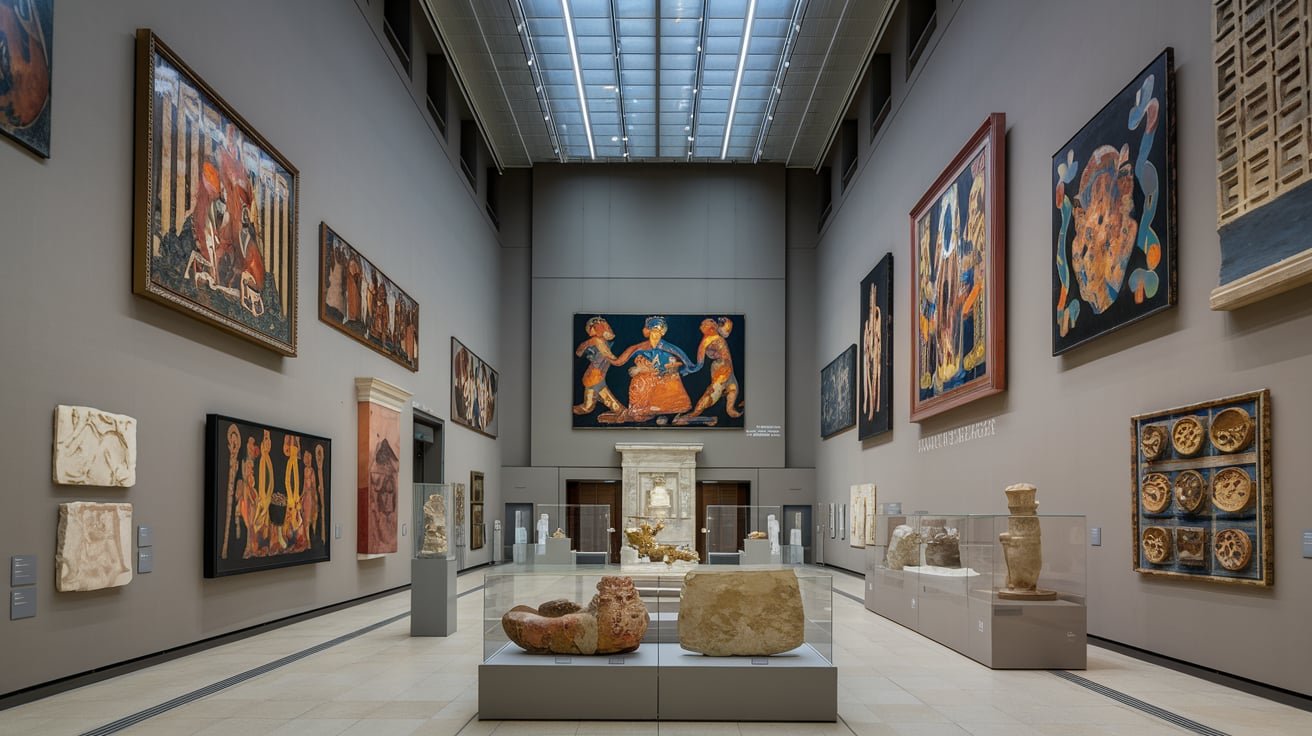Art has been a fundamental part of human culture and expression since the dawn of civilization, offering a glimpse into the lives, beliefs, and dreams of past societies. From ancient cave paintings to awe-inspiring sculptures and intricate pottery, ancient art holds timeless beauty and rich symbolism that continues to captivate us today. “Ancient Artz” delves into the wonders of art from civilizations around the world, exploring its significance, techniques, and legacy.
The Origins of Ancient Art
The beginnings of ancient art trace back to the earliest humans who expressed themselves through rudimentary drawings on cave walls. These early forms of expression, like those found in the Chauvet Cave in France or the Altamira Caves in Spain, are estimated to date back over 30,000 years. Created with natural pigments and simple tools, these images of animals, hunters, and geometric shapes reveal the beginnings of humanity’s urge to document and interpret the world.
This early art wasn’t merely decorative; it played an important role in the social and spiritual life of these communities. Archaeologists and art historians believe that ancient art served as a medium for storytelling, a means of sharing knowledge, and even as a form of ritualistic practice.
Ancient Egyptian Art: Symbolism and Divine Connection
Egyptian art is one of the most recognizable and studied forms of ancient expression. Characterized by its distinctive style and elaborate iconography, Egyptian art dates back to around 3000 BCE, a period that spans nearly three millennia of pharaonic rule. Egyptian art is highly symbolic and steeped in religious meaning, with many artworks created to honor the gods or to prepare individuals for the afterlife.
Statues of deities, wall reliefs in tombs, and elaborate hieroglyphics are all iconic elements of Egyptian art. Figures in Egyptian art were often depicted in strict profile, with a rigid stance that conveyed a sense of order and eternity. The colors in these pieces also held significant meaning—green represented fertility and rebirth, while black symbolized death and the afterlife.
The artistry in Egypt wasn’t limited to tomb paintings; sculptures like the Great Sphinx and monuments like the Pyramids of Giza showcased both technical mastery and spiritual purpose. This era also saw the development of portraiture, such as the bust of Queen Nefertiti, which epitomized beauty and skill in stone carving.
Mesopotamian Art: The Cradle of Civilization
Mesopotamia, often regarded as the “Cradle of Civilization,” was home to some of the earliest forms of urban culture, with societies flourishing along the Tigris and Euphrates rivers around 3500 BCE. Art in Mesopotamia took many forms, from the intricate cylinder seals used for personal identification to the grandiose ziggurats that served as religious temples.
Unlike Egyptian art, which focused heavily on the afterlife, Mesopotamian art primarily documented daily life, conquests, and societal hierarchy. The art was often utilitarian, with a focus on the power of rulers, as seen in the Stele of Hammurabi, which is inscribed with the ancient code of law. Clay tablets, stone reliefs, and architectural forms are typical of this region, illustrating its rich storytelling traditions and technological advancements.
The Art of the Greeks: A Celebration of Humanity and Beauty
Ancient Greece revolutionized the way we think about art, introducing realism, perspective, and the celebration of the human form. The Greeks pioneered three major artistic styles: Archaic, Classical, and Hellenistic. Archaic art, dating from 700 BCE to 480 BCE, was marked by a more rigid, formal style, often with statues known as kouros (male) and kore (female) figures that conveyed idealized human forms.
The Classical period, from around 480 BCE to 323 BCE, focused on capturing movement, proportion, and anatomy. The Greeks’ dedication to idealized beauty and form is evident in the works of sculptors like Phidias and Polykleitos, whose statues embody balance and naturalism. This era produced masterpieces such as the Parthenon and the famous statue of Athena, symbolizing wisdom and strength.
During the Hellenistic period, which followed Alexander the Great’s conquests, Greek art became even more dynamic and expressive. Artists began to depict more naturalistic figures, often showing a wide range of emotions and even the imperfections of the human body. The Laocoön Group and the Venus de Milo are prime examples, showcasing drama, emotion, and technical mastery.
Ancient Indian Art: Spirituality and Philosophy
The art of ancient India is deeply entwined with spirituality, myth, and philosophy. From the intricate sculptures of the Harappan Civilization to the breathtaking architecture of temples and stupas, Indian art reflects a diverse and rich culture. One of the earliest forms of Indian art comes from the Indus Valley Civilization, which existed around 2500 BCE and left behind terracotta figures, bronze sculptures, and seals adorned with animals and script.
Buddhism and Hinduism played a central role in shaping Indian art, as seen in the many depictions of deities, mythological narratives, and symbols like the lotus and the chakra. The Ajanta and Ellora caves in Maharashtra are prime examples of this period’s artistic legacy, with rock-cut temples and statues that tell the story of Buddhist teachings and Hindu myths.
In later periods, Indian art evolved with the rise of empires like the Maurya and Gupta, bringing forward grand architectural projects such as the Ashokan pillars and the temples of Khajuraho. These pieces show exceptional attention to detail, with graceful human figures and intricate carvings that continue to inspire contemporary artists and architects.
Chinese Art: Harmony with Nature and Philosophy
Chinese art, dating back thousands of years, is a testament to the country’s philosophy, literature, and reverence for nature. The Chinese view of art was more than a form of decoration; it was seen as a means to align oneself with nature and the cosmos. Calligraphy, pottery, and painting were key forms of expression, often accompanied by deep philosophical meanings.
One of the most enduring forms of Chinese art is the creation of bronze vessels during the Shang and Zhou dynasties, used in ritualistic practices and decorated with symbolic patterns. Chinese ceramics, particularly porcelain, achieved global renown and were highly prized in the ancient world.
The influence of Taoism and Confucianism is apparent in Chinese landscape paintings, where vast mountains, rivers, and scenes from nature were depicted in ink and brush, symbolizing harmony and balance. Figures like Gu Kaizhi and Wu Daozi were pioneers in this field, using art to reflect the natural world and the human spirit.
Ancient American Art: The Legacy of the Maya, Aztec, and Inca
The ancient civilizations of the Americas, such as the Maya, Aztec, and Inca, also produced remarkable art that reflected their values, beliefs, and way of life. Mayan art, for example, is celebrated for its detailed carvings, elaborate stucco friezes, and painted murals. These works were often religious in nature, depicting gods, rulers, and cosmic events that governed daily life.
Aztec art, on the other hand, showcased a powerful and fearsome style, with jaguar motifs, masks, and symbols of warfare. The Aztecs produced a range of artifacts from stone sculptures to feathered headdresses, often reflecting their reverence for gods like Quetzalcoatl, the feathered serpent.
The Inca civilization, based in the Andean region, is renowned for its architecture and textile work. The Inca used woven textiles as a significant form of artistic expression, with vibrant patterns that symbolized different aspects of their society. Their architectural marvels, such as Machu Picchu, reflect an impressive understanding of engineering and a respect for natural landscapes.
Legacy of Ancient Artz
The influence of ancient art persists across cultures and continues to shape the modern world. These masterpieces offer valuable insights into the beliefs, values, and innovations of past civilizations, reminding us of our shared heritage and artistic aspirations. Today, ancient art inspires artists, architects, and even tech creators as they draw from time-honored techniques and philosophies to create something timeless.
Moreover, as technology advances, ancient art is more accessible than ever. Digital recreations, museum collections, and online archives allow people worldwide to appreciate and study these treasures, ensuring they endure for generations to come.
Conclusion
“Ancient Artz” is more than a study of old artifacts; it’s a window into humanity’s past and a testament to the timeless nature of creativity. Whether through the spiritual motifs of India, the architectural marvels of Mesopotamia, or the emotive sculptures of Greece, ancient art tells the story of our ancestors and celebrates the universal human desire to understand and beautify the world around us. Through this journey, we recognize that art, in all its forms, connects us to our roots and continues to be an essential part of our identity and legacy.










